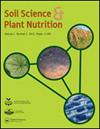The inorganic nitrogen fertilizer equivalency of hairy vetch (Vicia villosa Roth) as a winter green manure in Kanto and Tohoku district, Japan
IF 1.8
4区 农林科学
Q3 ENVIRONMENTAL SCIENCES
引用次数: 0
Abstract
ABSTRACT It is well known that legume green manure (GM) supplies nitrogen (N) to succeeding crops. However, in Japan, there are few experimental field studies that have quantitatively evaluated the effect of GM on the N supply. To estimate the inorganic N fertilizer equivalency of GM for the succeeding corn crop, two field experiments were conducted in 2012 at Morioka, Tohoku district (cool climate region) and in 2014 at Nasushiobara, Kanto district (warm temperate region). Each experiment had a split-plot design with a factorial arrangement of two cropping systems, hairy vetch [HV; Vicia villosa Roth] GM and conventional cultivation, with four N fertilizer treatments (0, 75, 150, and 225 kg N ha−1). In both sites, GM increased the N uptake and, as a result, the shoot yield of the succeeding forage (silage) corn. The apparent N recovery rates of HV shoot were 64% at Morioka and 24% at Nasushiobara. The inorganic N fertilizer equivalency rates of HV shoot were 82% at Morioka and 104% at Nasushiobara. In conclusion, by introducing HV as a GM, we can reduce the amount of inorganic N fertilizer applied to the succeeding corn crop with the same amount as at least 80% of N uptake in HV shoot.在日本关东和东北地区,野豌豆(Vicia villosa Roth)作为冬季绿肥的无机氮肥当量
众所周知,豆科绿肥(GM)为后续作物提供氮(N)。然而,在日本,很少有田间试验研究定量评价转基因对氮素供应的影响。为了估算转基因玉米后续作物的无机氮肥当量,分别于2012年和2014年分别在东北地区森冈和关东地区暖温带那素原进行了两次大田试验。每个试验都采用裂地设计,采用两种种植制度的析因安排,毛豆[HV];采用4种氮肥处理(0、75、150和225 kg N ha - 1)进行转基因和常规栽培。在这两个试验点,转基因提高了氮素吸收,从而提高了后续牧草(青贮)玉米的茎部产量。HV苗的表观氮素回收率在盛冈为64%,在真原为24%。盛冈和初原的HV地上部无机氮肥当量率分别为82%和104%。综上所述,通过引入HV作为转基因作物,我们可以减少后续玉米作物的无机氮肥用量,其用量至少相当于HV茎部氮素吸收量的80%。
本文章由计算机程序翻译,如有差异,请以英文原文为准。
求助全文
约1分钟内获得全文
求助全文
来源期刊

Soil Science and Plant Nutrition
农林科学-农艺学
CiteScore
4.80
自引率
15.00%
发文量
56
审稿时长
18-36 weeks
期刊介绍:
Soil Science and Plant Nutrition is the official English journal of the Japanese Society of Soil Science and Plant Nutrition (JSSSPN), and publishes original research and reviews in soil physics, chemistry and mineralogy; soil biology; plant nutrition; soil genesis, classification and survey; soil fertility; fertilizers and soil amendments; environment; socio cultural soil science. The Journal publishes full length papers, short papers, and reviews.
 求助内容:
求助内容: 应助结果提醒方式:
应助结果提醒方式:


